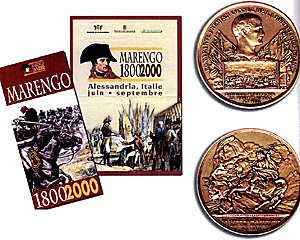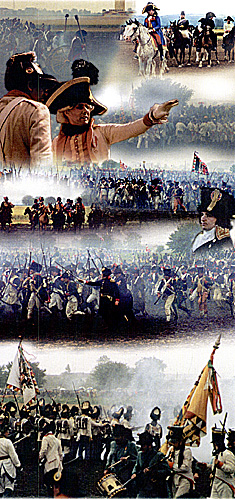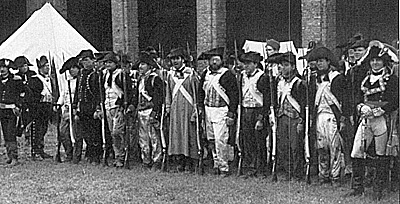
200 years ago Napoleon Bonaparte fought his first major battle after becoming head of France. It was the second campaign he conducted in Northern Italy, the same area he had won recognition and fame as a young general four years before. Unlike the campaign of 1796-97, in 1800 the 30-year-old First Consul's political office was at stake. In the next issue of Napoleon Journal we will present a retrospective examination of the myths and controversies of the Marengo campaign, including why Napoleon changed the official history. Here we offer a report on the 200th anniversary celebration of the battle recently held in Italy.
We had waited a long time for this one -- Marengo 2000 was the first of the "big ones" which would take us through to 2015 and Waterloo. For months, the main European reenactment commanders, Romain Baulesch and Stefan Roda, had struggled with the complexities of the local Italian systems, but at last we were there. The battlefield was somewhat unsatisfactory, merely a flat bit of ground with raised seating to the southern side. Nevertheless, it was next to the historic Marengo farm, where the reenactment commanders' headquarters was established, thanks to the gracious hospitality of its owner, Professor Gian Pietro Cellerino. You could not get much closer to the heart of the actual historical site than this.
 Walking down from Alessandria, it is very easy to see, despite its modernization, that Pedrabona farm dominated the approach to the Fontanone stream in 1800. If you imagine the marshy, enclosed ground, described in many memoirs, which was near-impassable for artillery, it becomes obvious why French General Gaspard Gardanne established his defensive position here. The Fontanone seems so peaceful now that you hardly notice it crossing at the site of the hotly-contested wooden bridge. Ahead, the Villa Marengo is visible, but the farm is now screened by trees.
Walking down from Alessandria, it is very easy to see, despite its modernization, that Pedrabona farm dominated the approach to the Fontanone stream in 1800. If you imagine the marshy, enclosed ground, described in many memoirs, which was near-impassable for artillery, it becomes obvious why French General Gaspard Gardanne established his defensive position here. The Fontanone seems so peaceful now that you hardly notice it crossing at the site of the hotly-contested wooden bridge. Ahead, the Villa Marengo is visible, but the farm is now screened by trees.
The Villa is the home of a small museum, which is well worth a visit. Further down the main road is the Memorial Park with a new stand of trees, but the famous vineyards which used to stand behind the village are now gone. In the park there is a battle ossuary and a monument to French General Louis Desaix, who was mortally wounded leading the charge that retrieved victory for Bonaparte and the French. Appropriately, wreathes had been laid, the ribbons in the Italian national colors signifying the prevalent belief that First Consul Bonaparte's campaigns in Italy marked the beginning of Italian unification.
The ground north of the park is more open than it was in 1800, but the Barbotta farm still dominates the area towards the Fontanone and it is easy to visualize French division commander Jean Lannes' position spread out towards that farm and then back to the Castel Ceriolo road. The ditch, which General Rivaud's cavalry brigade defended against the Austrian breakthrough over the Laufbrucken bridges, can still be seen.
On Saturday a parade was held as part of the pre-battle publicity. Several reenactors felt that the parade "was more physically exhausting than the battle. Two hours under arms, most of the time at attention, arms shouldered, in wool uniforms, with the oppressive sun and humidity, is enough to assure one that reenactors are daft."
After a quick walk around the Austrian campsite, it did not take long to locate Miro Luptak and his Slovakian IR2 Grenadiers. The Imperial army, reinforced with a British unit, was already developing an authentic multi-lingual babble when a recent addition in the shape of a small band struck up the Radetzky March. (Okay, it was composed long after the battle, and Austrian General Josef Radetzky was not even at Marengo!)
I found myself in the role of a double-spy as I then headed off down the far end of the battleground (really like a football field) to view the opposition -- the French camp with a large number of reenactors from the famous L'Incomparable 9th Light Regiment (the nickname was earned for their performance at Marengo). As I had been invited to join in their traditional Saturday night out, it did not seem the right moment to tell them that this title was also bestowed on the Bussy Jager mounted regiment by Austrian commander General Michael Melas in his after-battle report.
The Bar Bonaparte (what else?) in Spinetta was our destination and, unsurprisingly, the food was a decent version of Chicken Marengo, washed down with lashings of beer to the accompaniment of several songs. Unfortunately, the dry weather ended and throughout the night the rain fell in torrents with occasional flashes of lightning.
It was raining hard the next morning. The local Italians are obviously a stoic lot as they trooped through the park towards the arena. In the Villa courtyard, two brightly dressed bands, one Imperial Guard and the other blue-uniformed hussars, entertained a huddle of damp tourists with their own musical battle. The narrow roadway was getting muddy, and as the rain continued to fall the ground around the grand stands rapidly turned into a swamp. Umbrellas were soon up everywhere.
As the crowd steadily grew to fill the stands, a small force of Italian Carbinieri cavalry (mounted police) rode around the battleground, just to make sure it was thoroughly churned up. It now resembled a well-plowed wet field.
The reenactors were nevertheless going to perform and the Austrians advanced a little anxiously against the first small French line. Wisely, the small force of Austrian artillery, manned by Czech crews, decided to form up on the edge of the reenactment field. What they lacked in numbers, they certainly made up for in enthusiasm, keeping the guns going in the rain whenever it was safe to do so. Great clouds of smoke blew from the cannon muzzles over the crowd adding to the authenticity as the smoke began to envelop the battlefield. For entertainment purposes a reenactment has to move up and down the field, and for Marengo this would be entirely in keeping with the original battle. The Italian commentator could be heard occasionally through the rain as well as the sound of a helicopter circling with a film crew aboard. As the opposing troops made contact, the infantry began sinking deeper into the mud. Each step produced a boot with yet more of the gray-brown earth attached to it.
The clouds began to clear but intermittent showers continued to drench everyone. The front rank men found themselves dragging their own weight plus the men behind clinging on to their backpacks. The mud was so deep that Hans-Karl Weiss, a reenactor with the French 9th Light, said "You were literally sucked into it and sometimes you seemed to be glued into the ground and needed a push from your NCOs to overcome the suction of the mud. I saw soldiers lose their shoes and I was lucky to have tied some ropes around mine to prevent such a loss."
Although the Austrian infantry were advancing, the French enjoyed a large superiority in cavalry. The soft ground was somewhat easier for them and they could mount several raids against the hard-working artillerymen, as well as staged sword fights. One French reenactor, Sgt. Louis, reported that "the French and Russians spent the whole time trying to bayonet charge each other and avoid being trampled by various groups of cavalry who were whooping it up as if it were the Wild West!"
 The battle now resembled a "rugby scrum" to try and push the enemy off balance. All of this shoving was done with fixed bayonets! Fortunately, it was also done in good spirits, one French reenactor describing the action as "the Austrians (actually British KGL light infantry) who fought us were laughing as much as we as the lines jostled back and forth. They clearly understood our English and laughed accordingly as our soldierly commentary on the shoving match revealed we too had mastery of English language expletives."
The battle now resembled a "rugby scrum" to try and push the enemy off balance. All of this shoving was done with fixed bayonets! Fortunately, it was also done in good spirits, one French reenactor describing the action as "the Austrians (actually British KGL light infantry) who fought us were laughing as much as we as the lines jostled back and forth. They clearly understood our English and laughed accordingly as our soldierly commentary on the shoving match revealed we too had mastery of English language expletives."
As showers continued to fall, the French reinforcements arrived. To a mass of waved French hats, the 9e Legere arrived to turn the battle back in Bonaparte's favor. It wasn't going to be easy -- aside from the quagmire, the din of shouting and musketry recreated some of the chaos of the famous day 200 years ago. The two sides struggled in the mud to hold their ground, but eventually the pressure of French troops, supported by more attacks by their cavalry, prevailed. One spectator, Ian Edwards, described the battle as "organized chaos," but the crowd loved it and as one last desperate bout of Austrian resistance against French musketry closed the event, they applauded. Now there was just the muddy way back to their cars!
Dave Hollins is the author of Osprey's newest campaign book: Marengo: 1800.
Back to Table of Contents -- Napoleon #16
Back to Napoleon List of Issues
Back to MagWeb Master Magazine List
© Copyright 2001 by Napoleon LLC.
This article appears in MagWeb (Magazine Web) on the Internet World Wide Web.
The full text and graphics from other military history magazines and gaming magazines are available at http://www.magweb.com
Order Napoleon magazine direct